
#BlackLivesMatter
The constructed message of a movement
In this paper, I will analyze and describe how the Black Lives Matter movement uses new media to construct their message and create online and offline resistance.
#blacklivesmatters, a short history
Baltimore, Cleveland, Cincinnati, Ferguson, and Charleston. Do those names ring a bell? In each of these American cities, a similar incident took place. An unarmed black man died at the hands of a police officer, causing a multitude of discord in society. In several of the cases, there is video evidence of the incident. However, grand juries have tended to give the benefit of the doubt to police officers, causing discontent and anger amongst the black society. To show resistance, #BlackLivesMatter was born.
"It was a response to the anti-Black racism that permeates our society and also, unfortunately, our movements."
To start with, Trayvon Martin, a 17-year-old unarmed black American boy, was killed by neighborhood watch member George Zimmerman. The boy's death sparked awareness amongst African Americans in the United States. Three young women, Alicia Garza, Opal Tometi and Patrisse Cullors created the Black Lives Matter movement shortly after finding out George Zimmerman was not held accountable for the committed crime. Alicia Garza was the first that officially used the #BlackLivesMatter campaign. According to Garza, ‘’It was a response to the anti-Black racism that permeates our society and also, unfortunately, our movements.’’ (2014). In the three years after the horrific event of Trayvon Martin, we have watched one terrible encounter after another. All involving unarmed African Americans shot by the police. Black Lives Matter got more followers, started demonstrations and began creating awareness for inequality both online and offline.
Race relations
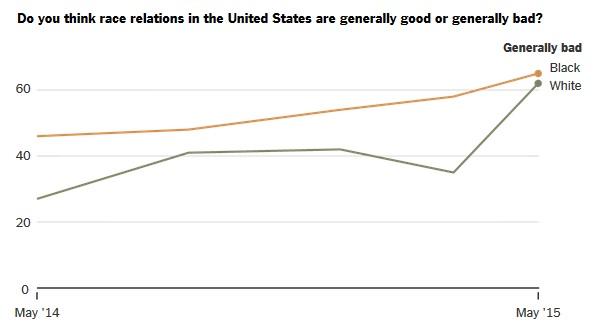
(Sussman, 2015)
In 2015, the New York Times published a research on safety and police interference. The graphic above is about the race relations in the United States. White and black citizens were both asked how they thought about these race relationships in the past twelve months (may 2014 until may 2015). All citizens felt the relations changed, and not in a good way. This had to do with the increasing police violence against blacks (Sussman, 2015). Remarkable is the fact that both the white and black citizens felt almost the same about those generally bad relations; this means that the society is aware of problems according to race. That awareness, is possibly one result of the Black Lives Matter movement. Today, the whole world knows that Blacks are still discriminated against in the US. Racism and institutional racist violence is not a thing from the past.
Online Message
To construct the online message of the BLM movement we have to construct a framework of the online world. Castells (2010) points out that in the 'network society', flows of information are exchanged at a rapid pace and possibly on a transnational scale. The movement is using these structures to make as many people aware of their anger and worries as possible. They use a lot of different platforms to succeed, i.e., Facebook, Twitter and Instagram, and they have a lot of followers. What stood out online for me was the fact that almost every big city in the United States has its own BLM platform. The movement is clearly polycentric and transnationally organized (Maly, forthcoming). I mostly looked at the official overarching platforms; however, on a smaller scale, a lot is actuated throughout local platforms, for example: 'Black Lives Matter Boston' or 'Black Lives Matter Chicago'.
According to the official website of Black Lives Matter, the movement is broadening the conversation around state violence. They include "all of the ways in which Black people are intentionally left powerless at the hands of the state" (2016). They stand for all black people: young, old, disabled and all black lives along the gender spectrum. On their social media platforms, they use every occasion to post something about the daily inequalities.
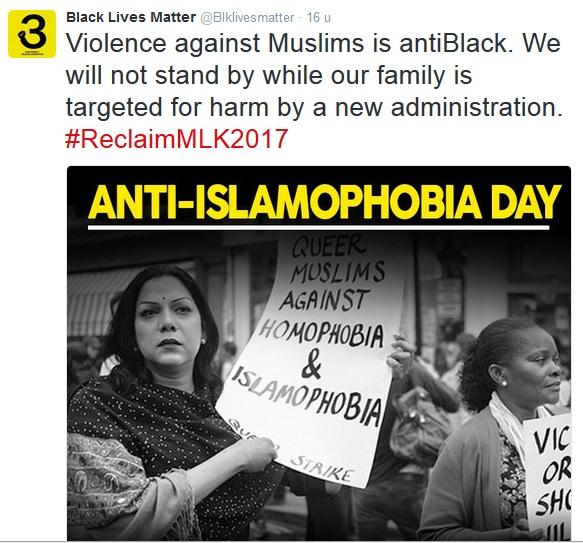
In this example the Black Lives Matter movement is demonstrating against violence agianst Muslims because this is anti-Black. This screenshot is taken from their Twitter page. The movement portrays itself as a platform for all black people. No difference has been made in religion or culture, Black Lives Matter is for all blacks. They seemingly unite on 'Blackness' (even though a lot of white people support the movement and are active participants). Other differences between them are negligible, which also is quite notable. Not often groups arise which have followers so different in age, culture, gender, religion and ideas.
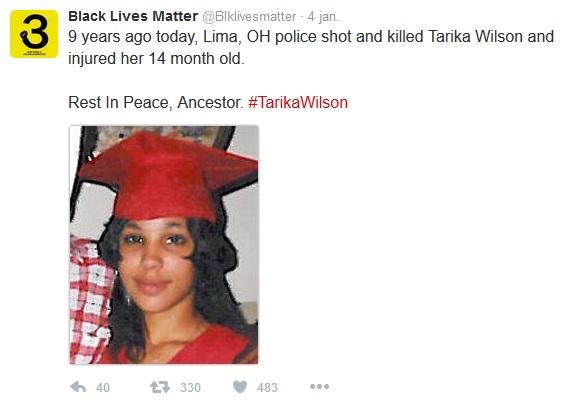
Also on Twitter, the movement commemorates a lot of African Americans killed due to violence or police interference. The movement wants to show they will not be forgotten and that they are the main reason the movement exists. The above tweet shows that Tarika Wilson was yet another example of an unarmed Black person shot and killed by the police.
For every victim a hashtag is used, for example, #TarikaWilson or #Ferguson. The #-symbol is often used to mark a conversation. In the case of #BlackLivesMatter, the hashtag marks the conversation of the unfair treatment of African Americans, a call for action and a response to the virulent anti-Black racism; furthermore, it is a mobilizing name. A mobilizing name is a name that is used for people to group themselves (Maly, 2016). The #TarikaWilson hashtag is about the young unarmed woman with her baby shot by the police (Maag, 2008). However, this #-symbol does not only mark a conversation but also allows users to frame their own comments, to make clear what it is really about. These hashtags show the importance of network and community. By using the hashtags, groups are easily made, maintained and identified. ''Twitter affords a unique platform for collectively identifying, articulating, and contesting racial injustices from the in-group perspectives of racialized populations'' (Bonila & Rosa, 2015). However, by using these hashtags it is also easy to miss important information about a certain subject because you tend to look only at the posts with the hashtag because those are the easiest to find. But these are not the only things written about the subject.
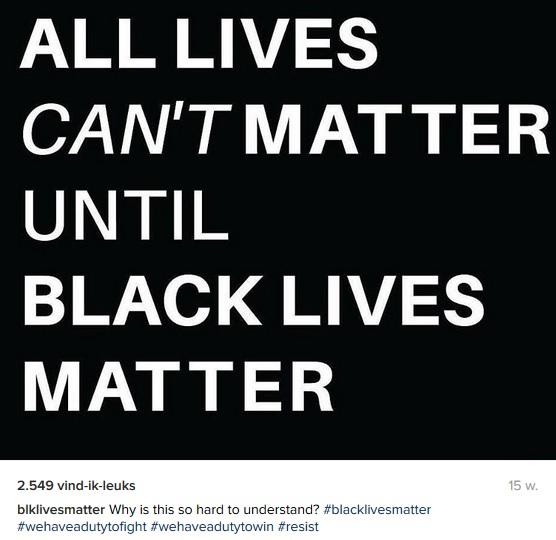
On the Instagram page, a lot of bold statements are made and many inspiring people come forward. Quotes of famous and less well-known black people are used to express the feelings of the black society, Martin Luther King for example. The movement wants to make a statement that they will fight this battle till the end and that their followers are not alone. By quoting all those famous people, they have a foundation for their standpoints. People look up to them and are more willing to follow the 'heroes'. The movement itself uses a lot of hashtags. In the example above, you see four different hashtags used. Mainly the last three hashtags encourage black people to do something about their situation: they have to resist, and they have a duty to win the battle they started. It almost sounds as if they have to go to war. This results in a lot of demonstrating online and also on the streets, and not all those demonstrations are peaceful and calm.
Offline Message
The movement organizes a lot of demonstrations all over the country, most organized locally. They want to show their fellow Americans that they are fed up with the current situation. The demonstrators congregate and walk through the streets of several big cities together. They make themselves visible and make sure people see and hear them by shouting and using big signs. They want to show the world that they are there, and that they want change. Only being visible online does not always causes change. By demonstrating on the streets, they aim to show what they really mean and that they are willing to fight for it.
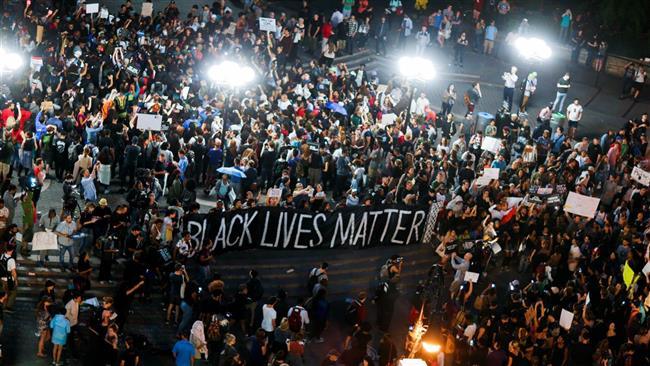
(PressTV, 2016)
In the photograph above you see a protest march through the streets of New York on July 9, 2016. Thousands of people came together after the 37-year-old Alton Sterling was shot by the police. During the march, they were shouting 'black power' and 'no justice, no peace, no racist police'. Most of the demonstrations are quite harmless, but some of them get out of hand. This protest in New York also escalated when people started throwing objects at the police. The message created by doing so is aggressive and did not cause understanding,
This video gives you an indication of the impact of some of the demonstrations and of the number of demonstrators present.
Because of these escalations, Black Lives Matter is not always living up to their own ideology, and may be hurting their own cause. Some demonstrators have gone too far with protesting. In Ferguson, after the death of Michael Brown, the city was set on fire during the demonstrations. This only counterworks what the movement wants to achieve because it does not raise understanding amongst the US citizens, only anger (Prestigiacomo, 2015).
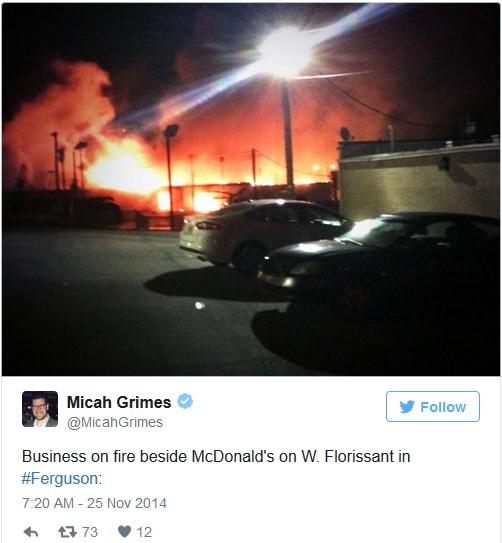
(Prestigiacomo, 2015)
''The message may be shallow, but the modulation of the message through the mass media converts it into a message of enormous importance.''
BLM worldwide
Black Lives Matter has a huge impact and many followers, not only in the United States. Through online media it is made easy to reach the other side of the world; within minutes or even seconds, news is shared with the rest of the world. By using and controlling their own media, Black Lives Matters escapes the margins and has a translocal impact. When president Obama started to get involved in the movement and even defended its standpoints it was clear that BLM really got big. In Australia, there were demonstrations under the name of Black Lives Matter (PressTV, 2016) and all around the world you see that local activist set up online media and use the banner #Blacklivesmatter in offline protests.
In the video above, President Obama speaks about the Black Lives Matter movement.
In the Netherlands we see the influences of the Black Lives Matter movement, for example, like in the tweet below. This tweet is about the Gouden Koets, a golden carriage the King and Queen of the Netherlands use once a year for a special occasion. On the carriage are paintings of the Dutch heritage; slavery is a part of this history. The hashtag in the example is used to express that this person is not proud of slavery in Dutch heritage, and encourages that the King and Queen not show these images again. So, we see that the hashtag immediately makes clear what this person means without him saying it in detail.
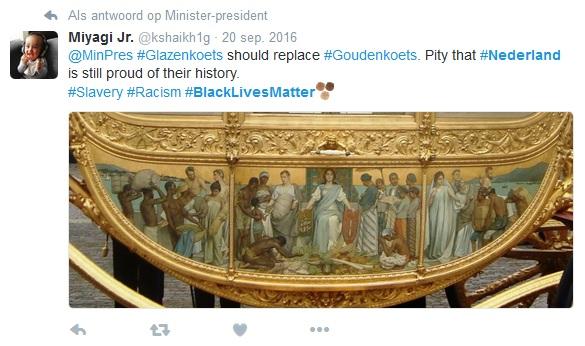
#Blacklivesmatter
In conclusion, the Black Lives Matter movement has grown enormously fast. It started with an online statement, but has grown into a worldwide campaign. The online world is of great importance to the movement to spread messages and encourage followers to take action. The message they express is to strive for equality. The online and the offline battle of the movement is deeply connected: there is no opposition between the "real" and physical offline reality and the online space. People gather, protest, fight precisely because online media allow them to quickly spread the word and organize. When the message hits the streets, the vested powers react, sometimes causing demonstrations get out of hand and police officers and African Americans even get killed.
The movement reaches people by using online platforms, and moreover, every big American city even has its own social media accounts for BLM. The hashtag is used in all kinds of situations because the message behind the hashtag includes many aspects. This movement grew so fast because so many people of the African-American society feel powerless and vulnerable.
African Americans still face inequality every day, even in small situations. Jonathan Capehart (2015) is one of them, he says: ''There are very few African Americans who haven’t had the experience of getting on an elevator and a woman clutching her purse nervously and holding her breath until she had a chance to get off. That happens often.'' I have to say this shocked me. It's clear that 'all lives matter' is not yet a reality, and that underscores the importance of Black Lives Matter.
References
Black Lives Matter. (2016). homepage (Accessed: 18 January 2017).
Blommaert, J. (2005). Discourse: Key topics in sociolinguistics. Cambridge: University Press.
Bonilla, Y. and Rosa, J. (2015) ‘#Ferguson: Digital protest, hashtag ethnography, and the racial politics of social media in the United States’, American Ethnologist, 42(1), pp. 4–17. doi: 10.1111/amet.12112.
Capehart, J.C.J. (2015) Opinion | from Trayvon Martin to ‘black lives matter’.
(Accessed: 18 January 2017).
Castells, M. (2010). The rise of networked society: Second edition with a new preface. Chichester: John Wiley & Sons Ltd.
Prestigiacomo, A. (2015) Ten times black lives matter ‘activists’ hurt their own cause. (Accessed: 18 January 2017).
Maly, I. (2016). New Media and politics Class 10 - 2016 -Hard boven hard - Occupy [PowerPoint Slides].
Maly, I. (forthcoming). New Media, New Resistance and Mass Media: a digital ethnographic analysis of the Hart Boven Hard movement in Belgium. in –In Papaioannou, T. & : Media Representations of Anti-Austerity Protests in the EU: Grievances, identity and agency. London: Routledge.
Matter, B.L. (2013) Black lives matter on Twitter. (Accessed: 18 January 2017).
PressTV (2016) PressTV-Americans pessimistic on race relations. (Accessed: 18 January 2017).
PressTV (2016) PressTV-Australians hold black lives matter rallies. (Accessed: 18 January 2017).
Garza, A. (2014) Black Lives Matters Her story (Accessed: 18 January 2017).
Maag, C. (2015) Police shooting of mother and infant exposes a city’s racial tension. (Accessed: 18 January 2017).
Sussman, D. (2015) Negative view of U.S. Race relations grows, poll finds. (Accessed: 18 January 2017).
Black lives matter (@blklivesmatter) • Instagram photos and videos (no date) (Accessed: 18 January 2017).